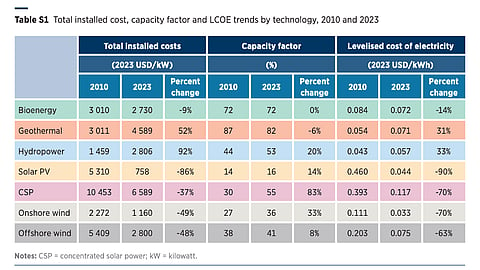

IRENA’s latest report delves into renewable energy generation costs between 2010 and 2023
It calls renewables the default source of least-cost new power generation technologies
Solar PV had the most defining cost decline among all other renewables, experienced significantly in 2023
The International Renewable Energy Agency (IRENA) says renewable power generation has become the default source of least-cost new power generation. The global costs of solar PV in 2023 were 56% lower than those of fossil fuels and nuclear power, thanks to a ‘spectacular decline in costs’ for this technology. Compare this to solar PV’s global weighted average at 414% higher than the cheapest fossil-fuel-fired solution in 2010.
Between 2010 and 2023, the total installed costs for solar PV declined by 86%, while its levelized cost of electricity (LCOE) dropped by 90%.
In its latest report titled Renewable Power Generation Costs in 2023, IRENA counts a record 473 GW of new renewable energy capacity to have been installed last year, representing a 54% year-on-year (YoY) increase, expanding the total global renewables capacity by 14% YoY to 3,865 GW.
In terms of renewable energy technologies, the cost decline was most prominent for solar PV as it experienced a total installed cost decline in major markets last year due to supply chain easing and reductions in commodity price inflation.
Of the 473 GW, 81% or 382 GW of newly commissioned, utility-scale projects had lower costs than their fossil-fuel alternatives which makes the socio-economic benefits of renewable energy deployment ‘uniquely compelling.’ Solar PV added 346 GW while onshore wind added 104 GW, both growing by 73% and 48% YoY, respectively.
In 2023, renewable energy costs registered a significant decline with the global LCOE from utility-scale solar PV projects declining by 12% to $0.044/kWh. For onshore wind, this decline was 3% to $0.033/kWh.
For offshore wind, the cost of electricity declined by 7%, 4% for CSP, and 7% for hydropower, while increasing 14% for bioenergy and 23% for geothermal.
The largest drop in installed costs was registered in the European nations, with Greece alone seeing a decline of 28%, the Netherlands 41%, and Germany 29%.
The world’s largest solar PV market China saw a decline of 10%, while the US and Brazil registered a 4% and 5% annual decrease in installed costs, respectively. India, on the other hand, recorded a 7% increase in costs.
Global renewable energy deployment since 2000 has also contributed to the world saving up to $409 billion in fuel costs in the power sector.
“Renewable power is increasingly cost-competitive with fossil fuels – 81% of renewable capacity additions in 2023 produce cheaper electricity than fossil fuel alternatives – and the accelerated deployment of renewable power continues to trigger technology advancements in a virtuous cycle of production efficiency and cost reduction,” stated IRENA Director-General Francesco La Camera.
This means that the prices for renewables are no more an excuse, but rather present a key incentive to triple renewable power capacity by 2030 to 11.2 TW, as agreed to by over 130 countries at COP28.
The achievement of this 11.2 TW target requires the addition of 1,044 GW annually on average through 2030, according to IRENA’s assessment, with a total of 8.5 TW coming from solar PV and onshore wind alone.
The report writers now recommend that policymakers and stakeholders focus on ensuring that policies, regulations, market structures, support instruments, de-risking mechanisms, and financing are all rapidly aligned with the tripling target. These must also be submitted in the next round of Nationally Determined Contributions to the Paris Agreement in 2025.
The complete IRENA report is available for free download on its website.
